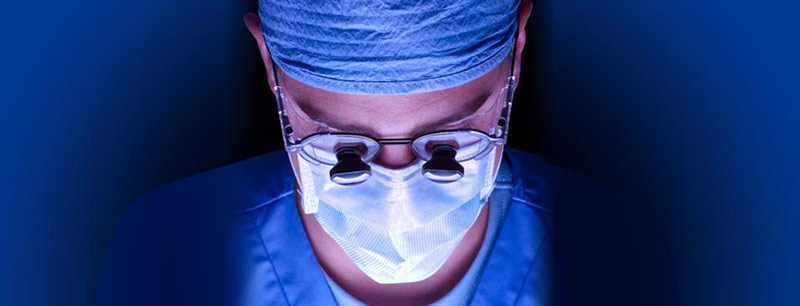Laser surgery
What types of problems in the larynx (voice box) require microsurgery?
The vocal cords are located in the larynx. Sound that comes from the vibration of the vocal cords is the primary source of speaking and singing. The lining of the vocal cords is the mucosa. Any lumps, bumps, or irregularities on or underneath the vocal cord mucosa can make it vibrate abnormally and cause a voice change. Vocal cord polyps, nodules, cysts, and papilloma are some of the benign lesions that can develop on the vocal cords.
What is the treatment for lesions on the vocal cords?

- The treatment of vocal cord lesions depends on the nature of the problem and the degree of voice change
- Medications, speech therapy and laryngeal microsurgery are the more common types of treatment for these conditions and may be used alone or in combination
- Microsurgery is recommended after accurate ear, nose and throat assessment and consideration of the specific voice disorder
How is the surgery performed?

- Laryngeal microsurgery is usually an outpatient procedure done in hospital
- The operation lasts for around 60 to 90 minutes and most patients go home the same day
- The surgery is performed under general anaesthesia and a surgical camera is placed to see the larynx directly – with the image shown on a surgical monitor
- Precision microlaryngeal instruments including the surgical laser are used to perform the surgery
- The specific details of the surgery depend on the type of lesion but the general goal is to remove the lesion with minimal disturbance to the adjacent normal tissue
What are the risks of laryngeal microsurgery?
The risks of surgery include but are not limited to:
- Risks of general anaesthesia
- Disturbance to the structures in and around the mouth can occur due to placement of the breathing tube or surgical instruments
- A mild sore throat, sore or temporarily numb tongue are not uncommon
- Voice improvement after the operation is the usual goal of surgery and is almost always accomplished but cannot be guaranteed
- Laser risks
What about using my voice after the procedure?
- The duration of voice reset depends on the underlying problem and the demands you place upon your voice
- As a general guide voice rest for the first five days after surgery is recommended
- As the vocal cords heal talking in a normal conversational voice is best – whispering and speaking loudly or shouting are not advisable
- Singing may recommence after 2 to three weeks but limited to 20 minutes per day
- After 6 weeks following surgery usually no limitations in talking or singing are needed
What things should I be concerned about after microlaryngoscopy?
If you develop any of the conditions listed below or have other concerns you should visit your local doctor or local emergency room who will contact your surgeon:
- Difficulty breathing
- Temperature above 38.5 degrees
- Persistent nausea and vomiting
- Persistent bright red blood in the saliva
- Difficulty eating and drinking or increase in throat pain
What should I expect after the procedure?
- A mild sore throat and mouth are common experiences after microlaryngoscopy
- There is often temporary hoarseness – voice improvement is usually gradual over weeks
- Nausea and a generally tired feeling are common after general anaesthesia and usually resolves within 24 to 48 hours
- A prescription for pain medicine, an antibiotic and anti-nausea medicine will be given as needed
- Plan to be off work at least until the first post-operative visit after around one week – a second visit is scheduled after around six weeks. You need to contact the office to confirm these appointments
Voice care tips
- Avoid whispering or shouting
- Avoid alcoholic drinks
- No smoking or smoky environments
- Limit telephone usage
- Keep your throat moist by sipping water or juice throughout the day and by chewing gum
- Allow for periods of vocal rest with no talking and no whispering
- Minimise coughing, hacking and throat clearing
- Use electronic amplification where necessary
- Do not attempt to speak over noise
- Rest your voice after singing, lecturing, etc.




